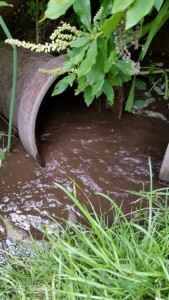Willow Pond Rain Garden

The Willow Pond Rain Garden was designed to slow the velocity of storm water input into the pond; capture harmful, nutrient rich sediment; and protect water quality. During rain events, the captured water slowly rises and flows over a stone weir before entering a bio-filtration pool inside of the pond. Installed in 2016, the Rain Garden has also improved habitat for amphibians, reptiles, birds, and invertebrates.
Project Overview
Willow Pond has long been at the forefront of Mount Auburn’s aquatic habitat improvement initiatives. In 2003 the pond was dredged to remove nutrient-laden organic matter in an attempt to discourage algae and bacterial growth while also increasing water depth. Coinciding with the pond’s dredging, the Cemetery installed an emergent plant shelf at the northern end of the pond. The root systems of the semi-aquatic plants planted in this shelf act as a natural filter for the storm water that enters the pond through drainage pipes. A small butterfly garden was added to the western edge of the pond in 2005, in part to provide habitat for butterflies and in part to add summer-time interest to one of the most frequently visited areas of the Cemetery. These projects have yielded an improved habitat for amphibians, reptiles, fish, birds, and insects. It is now quite common to hear the call of bullfrogs, observe turtles basking on the berm of the emergent shelf, witness a great blue heron hunt for fish in the shallows, or become hypnotized by the dance of dragonflies above the water.

Virtually all of Mount Auburn’s catch basins have dirt bottoms, which allows for water to recharge the aquifer below. In large rain events, the drainage pipes that connect the catch basins force water to flow into one of the three major water bodies – Halcyon Lake, Auburn Lake or Willow Pond.
Climate disruption, however, has impacted the previous restorations at Willow Pond. With an increasing number of powerful rain events, a higher volume and stronger velocity of storm water is entering our underground drainage system more frequently, inhibiting the effectiveness of the bio-filtration process at the previously installed aquatic emergent shelf. As part of our Wildlife Action Plan, environmental consultants from New England Environmental, Inc. designed an improved storm water management system that would improve the water quality at Willow Pond while adding additional habitat value for a variety of wildlife.
Built in 2016, the Willow Pond Rain Garden is a rocky depression built into the banks of Willow Pond along its northern edge. In rain events, water flows from storm water drains into this rocky pool where native stones help to reduce the water’s damaging velocity and trap its nutrient-laden sediment. A stone weir separating the rain garden from the actual pond holds and slowly discharges the storm water from the rain garden into the existing emergent shelf, where the final filtering process occurs before the water enters the main body of the pond.
- Storm water flows into the rain garden from the north.
- The native stones lining the garden help to decrease the velocity of storm water during heavy rain events.
- A stone weir holds the storm water in this pool until it is more gradually discharged into the actual pond.
The Plants
The Willow Pond Rain Garden was planted with species that can tolerate periods of submergence in water as well as provide food and cover for resident wildlife. The plan below illustrates the planting zones surrounding the rocky channel at the center of the garden. Click on the buttons below to see the shrubs, grasses and herbaceous perennials planted in the garden.
Willow Pond Rain Garden Planting Plan by New England Environmental, Inc.
This project was completed with approval from the Watertown Conservation Commission.




Leave a Reply